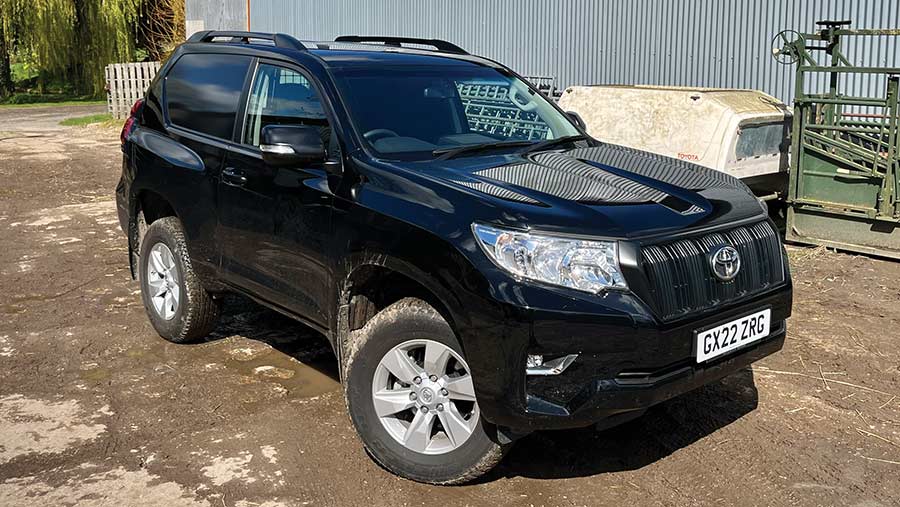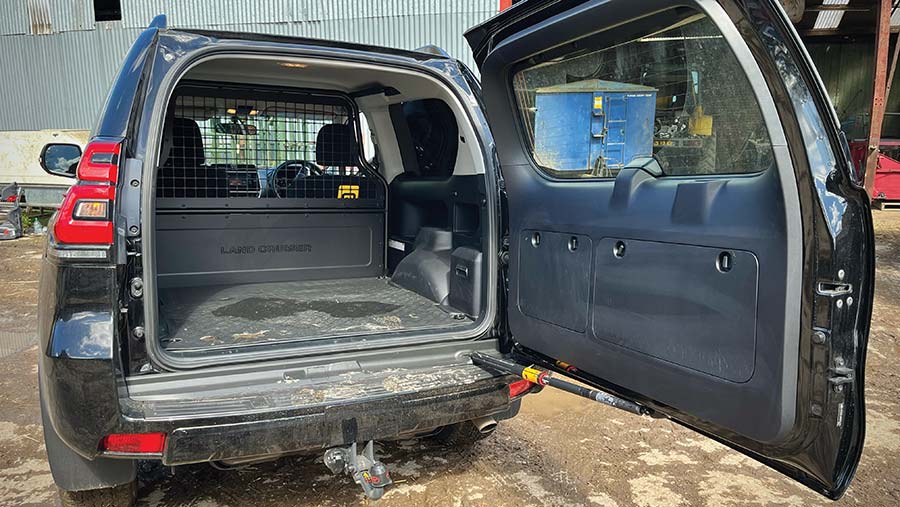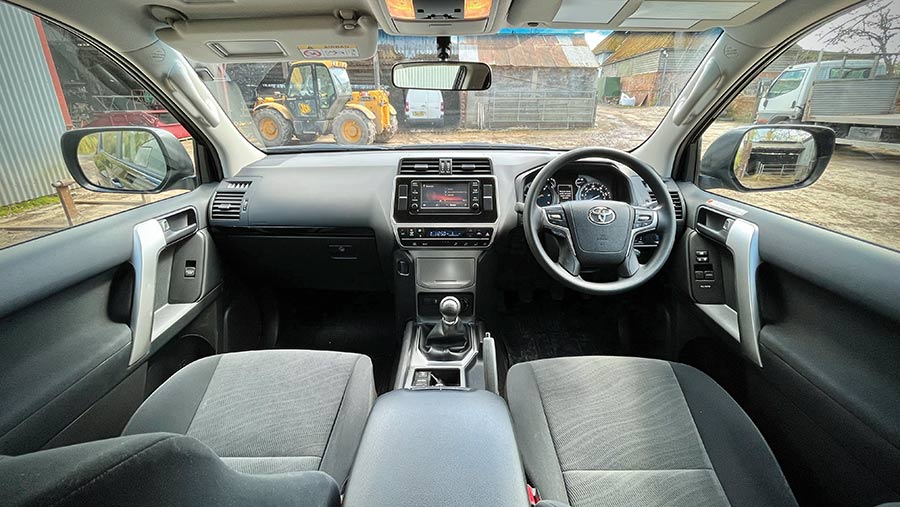Toyota’s rough and tough Land Cruiser, ugly but unrivalled
 © MAG/Oliver Mark
© MAG/Oliver Mark Strangling emissions regulations, a slump in demand and a surge in competition has left farm-friendly 4x4s on the cusp of extinction.
The iconic Land Rover Defender 90 copped it nigh on seven years ago and the Mitsubishi Shogun was culled in the UK soon after.
Not even the diminutive Suzuki Jimny could escape the onslaught and now remains in commercial guise only.
See also: On test: Land Rover’s plug-in hybrid Defender
Mercifully, one is still registering a pulse, with the Toyota Land Cruiser stoically clinging on to wage lonely war with an army of slick SUVs.
And while many of those faux-4x4s get a fancy monocoque chassis, spiffy tinwork and all manner of electronic sorcery to sustain traction on the school run, the lone automotive dinosaur counts on time-proven engineering to keep the wheels turning.
It’s built to outlast its owner but, in prioritising reliability, Toyota has deprived its charge of any meaningful 21st century improvements.
Even by retro cool standards its styleless curves, odd proportions and string curtain-like front grille are desperately dated, and the interior is devoid of anything remotely approaching avant-garde.
But that’s exactly why it’s a gem in a mine of mediocrity.
Little more than a lump hammer and spanner set should be enough to keep the old girl going, evidenced in the Farmers Weekly archives where scores of faithful examples were nearing the half-a-million-mile mark at the time of writing.
Countless more will have trumped that milestone.
Sold in 190 countries, it remains the vehicle of choice for the swarms of weapon-wielding rebels in Syria and Sudan, dune-bashing Arabians and Emiratis, and expedition leaders across South America, Siberia, Australia and Antarctica.
There can be few places on earth the Land Cruiser hasn’t seen.
Anything new?
The manufacturing recipe, like that of great-granny’s Christmas pudding, has changed little through the generations.
First built in 1955 as a truck-derived military vehicle, it took on the Land Cruiser moniker in 1966 as the firm’s debut station wagon.
The latest refinements came in 2020, when the rumbling 2.8-litre engine gained a little more thump (now 204hp).
Credit for this improvement goes, in part, to a smaller turbocharger that delivers sharper throttle performance, and which serves up maximum torque through an extended rev range starting at just 1,400rpm.
External nips and tucks have also reduced drag, helping to carve 2.8sec off the 0-62mph sprint.
That’s enough to embarrass an Isuzu D-Max and leaves it only a gnat’s doodah behind the new Volkswagen Amarok V6. Esteemed company, indeed.
At the same time, Toyota chose to rationalise the line-up, leaving just two variants.
The cheaper Active models start with the two-door, three-seat Utility commercial seen here and at the summit is the seven-seat Invincible.
What’s it like to drive?
Everything is built off an old-school ladder frame with angled steel cross-members that allow it to slide, rather than clatter, over hazards.
This setup does a decent job of absorbing the vibration and noise from the engine, drivetrain and road, and some added sound-proofing has helped too.
It is surprisingly serene to drive, though echoey rattles do emanate from the boot when it’s bereft of cargo.
Permanent four-wheel drive from the manual six-cogger comes by way of a Torsen limited-slip central differential.
The addition of a motorised actuator has made for easier shifting between high and low ratios, and the lockable rear diff has been fortified to handle 34% more torque.
Electronic input is limited to multi-terrain ABS and active traction control, hill start assist and a downhill control system.
When switched on with low range selected, this automatically pegs vehicle speed at roughly 4mph without the driver dabbing either brake or accelerator.
And it’s a handy addition, given the Land Cruiser’s high front trim and ferocious approach and departure angles allow ballsy drivers to tackle slopes that would be out of the question for most pickups.
On the road, the steering is slightly ponderous and the suspension spongy, but the ride is by no means galumphing and drivers will find unexpected comfort in an A-road schlep.
Boot

© MAG/Oliver Mark
Whipping out the rear seats has left a 1,600-litre boot furnished with nothing but a heavy, hose-down rubber mat and a handful of lash-down points.
The adaptation from passenger vehicle is relatively crude, with the seatbelt cut-outs left in the trim and a mesh bulkhead that, though useful in keeping the hounds at bay, has a habit of sending the driver cross-eyed through the rear-view mirror.
Nonetheless, for many farmers this setup will be more practical than a hardtop-equipped pickup, providing more floor-to-ceiling space and better security for tools.
However, it’s only 1.3m deep and the full-size, side-hinged door means there’s no option of a drop-down tailgate to accommodate fence posts and the like.
Towing capacity is also pinned at 3t, though power certainly isn’t the limiting factor.
Cab

© MAG/Oliver Mark
Depending on which side of the fence you sit, the cab is either charmingly simple or crudely dated.
The finish will be somewhat rag-tag for those accustomed to more opulent surroundings, with armchair-like cloth seats (remember those?) and just a handful chunky buttons that are almost comically old-fashioned but perfectly easy to find when bobbing along a rut-ridden track.
Storage cubbies are abundant – not all a useful shape and size, but the big central bin and top-of-dash tray are good – and there’s space behind the seats to wedge in a couple of coats, a map (no satnav) and a potpourri of farming paraphernalia.
There’s also a manual handbrake that, if nothing else, makes for easy do-it-yourself rear brake replacements.
A 90s-throwback LCD screen – itself not far off a place in the modern history museum – displays temperature and time read-outs.
That said, Toyota has given it a gentle nudge into this millennium with push-button start, automatic headlights, cruise control and a tyre pressure monitor, plus a small colour information screen in the middle.
On the basic three-door Active this acts as little more than a radio, with Bluetooth to take hands-free phone calls.
Toyota Land Cruiser Utility three-door spec
- Engine 2.8-litre D-4D four-cylinder diesel
- Max power 204hp@3,000rpm
- Max torque 420Nm@1,400rpm
- Transmission Six-speed manual
- Max speed 108mph
- 0-62mph 9.9sec
- Combined consumption 28mpg
- Wheelbase 2,450mm
- Minimum ground clearance 205mm
- Turning radius 5.2m
- Standard wheels 17in alloys on 265/65 R17s
- Kerb weight 1,975kg
- Towing capacity 3,000kg
- On-the-road price £36,187 (ex vat)
Farmers Weekly verdict
Toyota has stuck doggedly to the ‘ain’t broken, don’t fix it’ maxim.
That means there’s no shortage of concessions but, for farming buyers that spend as much time off road as on, its simplicity, reliability and ground clearance are priceless.
Whether the Land Cruiser can stay relevant in the headwinds of emissions legislation and changing customer demands remains to be seen.
Likes
✔ Feels indestructible
✔ Super reliable and easily fixed
✔ Stacks of torque at low revs
Gripes
✘ 3t towing limit
✘ High climb into the cab
✘ Not as cheap as you’d like

